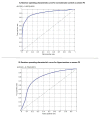Photoplethysmography and Heart Rate Variability for the Diagnosis of Preeclampsia
- PMID: 28991110
- PMCID: PMC5820156
- DOI: 10.1213/ANE.0000000000002532
Photoplethysmography and Heart Rate Variability for the Diagnosis of Preeclampsia
Abstract
Background: The goal of this study was to determine a set of timing, shape, and statistical features available through noninvasive monitoring of maternal electrocardiogram and photoplethysmography that identifies preeclamptic patients.
Methods: Pregnant women admitted to Labor and Delivery were monitored with pulse oximetry and electrocardiogram for 30 minutes. Photoplethysmogram features and heart rate variability were extracted from each data set and applied to a sequential feature selection algorithm to discriminate women with preeclampsia with severe features, from normotensive and hypertensive controls. The classification boundary was chosen to minimize the expected misclassification cost. The prior probabilities of the misclassification costs were assumed to be equal.
Results: Thirty-seven patients with clinically diagnosed preeclampsia with severe features were compared with 43 normotensive controls; all were in early labor or beginning induction. Six variables were used in the final model. The area under the receiver operating characteristic curve was 0.907 (standard error [SE] = 0.004) (sensitivity 78.2% [SE = 0.3%], specificity 89.9% [SE = 0.1%]) with a positive predictive value of 0.883 (SE = 0.001). Twenty-eight subjects with chronic or gestational hypertension were compared with the same preeclampsia group, generating a model with 5 features with an area under the curve of 0.795 (SE = 0.007; sensitivity 79.0% [SE = 0.2%], specificity 68.7% [SE = 0.4%]), and a positive predictive value of 0.799 (SE = 0.002).
Conclusions: Vascular parameters, as assessed noninvasively by photoplethysmography and heart rate variability, may have a role in screening women suspected of having preeclampsia, particularly in areas with limited resources.
Conflict of interest statement
NRE (TYE’s husband) is the President, and Drs. Michalopoulos and Singh are employees, and Dr. Darmanjian was an employee of Convergent Engineering. TYE is listed on patents filed for some of the technology described in this paper. The remaining authors report no conflicts of interest.
Figures


Similar articles
-
Coupling of heart rate and systolic blood pressure in hypertensive pregnancy.Methods Inf Med. 2014;53(4):286-90. doi: 10.3414/ME13-02-0045. Epub 2014 Jul 31. Methods Inf Med. 2014. PMID: 25077755
-
Measurement of area difference ratio of Photoplethysmographic pulse wave in patients with pre-eclampsia.BMC Pregnancy Childbirth. 2018 Jul 3;18(1):280. doi: 10.1186/s12884-018-1914-y. BMC Pregnancy Childbirth. 2018. PMID: 29970018 Free PMC article.
-
Ambulatory blood pressure monitoring for the early identification of hypertension in pregnancy.Chronobiol Int. 2013 Mar;30(1-2):233-59. doi: 10.3109/07420528.2012.714687. Epub 2012 Sep 24. Chronobiol Int. 2013. PMID: 23006127
-
Proteinuria during pregnancy: definition, pathophysiology, methodology, and clinical significance.Am J Obstet Gynecol. 2022 Feb;226(2S):S819-S834. doi: 10.1016/j.ajog.2020.08.108. Epub 2020 Sep 1. Am J Obstet Gynecol. 2022. PMID: 32882208 Review.
-
[Differences and similarities of preeclampsia and gestational hypertension].Ginecol Obstet Mex. 2005 Jan;73(1):48-53. Ginecol Obstet Mex. 2005. PMID: 15847148 Review. Spanish.
Cited by
-
Overview of Wearable Healthcare Devices for Clinical Decision Support in the Prehospital Setting.Sensors (Basel). 2024 Dec 22;24(24):8204. doi: 10.3390/s24248204. Sensors (Basel). 2024. PMID: 39771939 Free PMC article. Review.
-
Wearable Photoplethysmography for Cardiovascular Monitoring.Proc IEEE Inst Electr Electron Eng. 2022 Mar 11;110(3):355-381. doi: 10.1109/JPROC.2022.3149785. Proc IEEE Inst Electr Electron Eng. 2022. PMID: 35356509 Free PMC article.
-
Can Photoplethysmography Replace Arterial Blood Pressure in the Assessment of Blood Pressure?J Clin Med. 2018 Sep 30;7(10):316. doi: 10.3390/jcm7100316. J Clin Med. 2018. PMID: 30274376 Free PMC article.
-
Accuracy Assessment of Oura Ring Nocturnal Heart Rate and Heart Rate Variability in Comparison With Electrocardiography in Time and Frequency Domains: Comprehensive Analysis.J Med Internet Res. 2022 Jan 18;24(1):e27487. doi: 10.2196/27487. J Med Internet Res. 2022. PMID: 35040799 Free PMC article.
-
The impact of healthy pregnancy on features of heart rate variability and pulse wave morphology derived from wrist-worn photoplethysmography.Sci Rep. 2023 Nov 30;13(1):21100. doi: 10.1038/s41598-023-47980-2. Sci Rep. 2023. PMID: 38036597 Free PMC article.
References
-
- Lo JO, Mission JF, Caughey AB. Hypertensive disease of pregnancy and maternal mortality. Curr Opin Obstet Gynecol. 2013;25:124–132. - PubMed
-
- Rönnback M, Lampinen K, Groop PH, Kaaja R. Pulse wave reflection in currently and previously preeclamptic women. Hypertens Pregnancy. 2005;24:171–180. - PubMed
-
- Coppadoro A, Berra L, Bittner EA, Ecker JL, Pian-Smith MCM. Altered arterial compliance in hypertensive pregnant women is associated with preeclampsia. Anesth Analg. 2013;116:1050–1056. - PubMed
-
- Khalil AA, Cooper DJ, Harrington KF. Pulse wave analysis: a preliminary study of a novel technique for the prediction of pre-eclampsia. BJOG. 2009;116:268–276. discussion 276–277. - PubMed
-
- Avni B, Frenkel G, Shahar L, Golik A, Sherman D, Dishy V. Aortic stiffness in normal and hypertensive pregnancy. Blood Press. 2010;19:11–15. - PubMed
Publication types
MeSH terms
Grants and funding
LinkOut - more resources
Full Text Sources
Other Literature Sources

